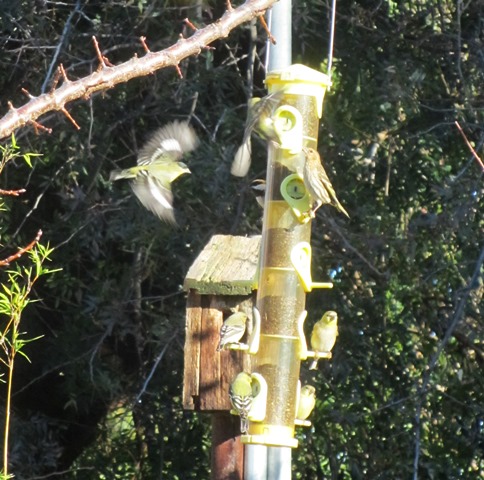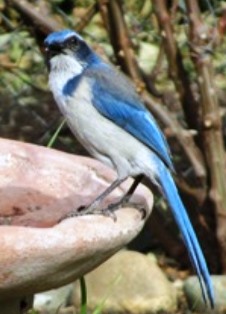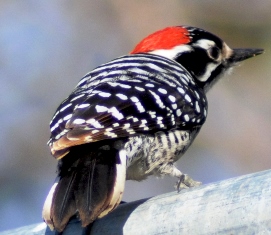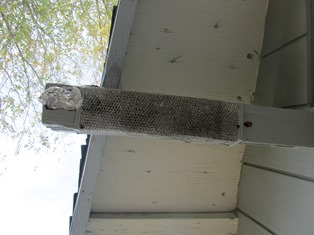Helping the Wildlife Make It through Winter
Our farmette has been experiencing traffic congestion from the wild birds flying in to dine at the feeders that I’ve recently filled.
I’ve also hung seeded suet cakes (especially favored by the Nuttal’s Woodpecker who knows exactly where the snack is hanging on the back fence).
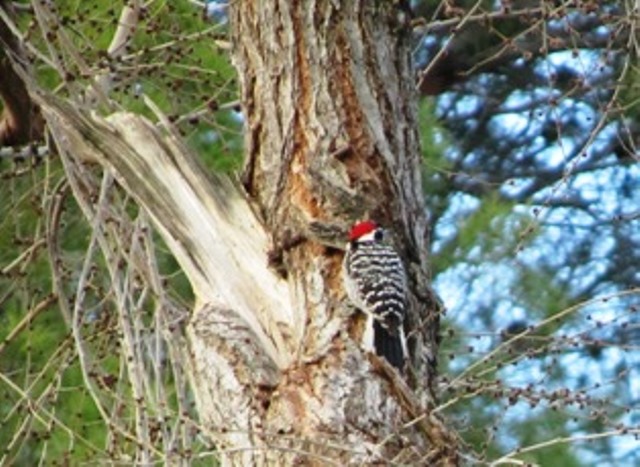
The Nuttall’s Woodpecker appears as a dash of brilliant red with black-and-white stripes wherever it perches
There are hawks doing fly-overs and blue jays flitting from the bushes to the trees.
But I especially love the little wild bird we call Crew Cut, a black phoebe that is building a nest in one of my apricot trees. And today, I spotted a Western bluebird on the fence at the front of our property.
This time of year when there is little for birds to forage on, I believe in providing bird seed, suet cakes, sunflower seeds, and peanuts for our feathered friends. I love to see them at the feeders and hope they’ll stay around to build nests in the spring.
Pair Bonding and Nest Building Is for the Birds
Nothing is sweeter to this farmette owner’s ears that the trills, tweets, and peet-a-weets of the backyard songbirds. Of late, we’ve been highly entertained, especially since the male songbirds seem to be in courtship mode, singing and doing air acrobatics in an effort to woo a female into bonding with them. Nest building comes after that.

Mourning Doves mate for life; these two are joined at the feeder by a third who has lost her partner
The Mourning Doves sound their plaintive call during flight or at rest on a wire waiting for the right time to alight on the ground, which is where they prefer to feed. Lately, however, I’ve seen a pair feeding together in the tight space around a feeder. Of late, a third has joined them.
The Western Scrub Jay isn’t really a songbird. He competes with the mockingbird, who is especially vocal, for the highest perch in the tree where it sits lookout and squawks until it spots an acorn and swoops down to take it in its beak for burial, most likely somewhere in my yard. At first, we saw only one or two jays and now there are four or more hanging out near the many feeders and suet cakes that we’ve hung for the birds.
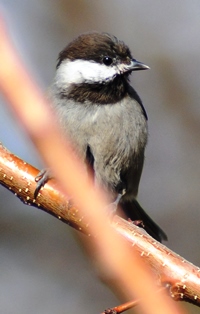
The Gray-headed Chickadee’s habitat is in northwestern Canada and Alaska, so what’s it doing on a Bay Area farmette?
The above bird passed through and posed long enough for a picture in our apricot tree. We think it is a Gray-headed Chickadee, but when we look the bird up in the Audubon book, it seemed unlikely since that bird doesn’t travel through Northern California. Still, the image of our bird seems to match exactly that of a Gray-headed Chickadee.
The flashiest bird of all in our backyard hangs upside down at the suet box, pecking away at the embedded seeds and pieces of fruit in the suet cake. He’s the Nuttall’s woodpecker and he’s found a mate. She’s hanging around, scouting out nesting sites. We’re trying to deter them from using a hole in our old farmette roof strut, but I think we’re losing the battle. Every morning, we hear the rat-ta-tat-tatting of bird beak against wood near the front porch. I’ve covered each hole they’ve made, but they keep drilling new ones.
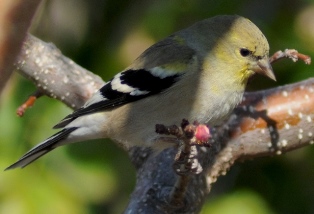
The Pine Warbler perches contentedly in the apricot tree after dining on insects, bugs, larvae, spiders, and caterpillars as well as the fruit and seeds embedded in the suet cake
Another bird that proved difficult for us to identify is the above pictured Pine Warbler. We have a massive pine tree in front of the farmette and with the suet cakes hanging at the back, this guy must have moseyed from the tall pine tree to drop in and taste a bit. These birds sing a rapid 10 to 30 notes at a time, usually on one pitch. Like most songbirds, they have song and also have defensive sounds, like a rattle call or a short, sharp note they sound to warn of predators or danger.
The Woodpecker Saga Continues
The woodpecker is back and apparently intent on taking down our roof strut. As I’ve mentioned in a previous blog, I believe it is a Nuttall’s Woodpecker (Picoides nuttallii) and possibly a female because of its small size and lack of red color on the back of the head and nape of the neck. The bird was named for naturalist Thomas Nuttal in 1843. It doesn’t eat acorns, yet its habitat is California oak woodlands.
After making two holes large enough to all but obscure the creature pecking away inside the beam, the woodpecker took off after I shooed him away. But despite me screwing in a screen to cover the two gaping holes, the woodpecker has created two new holes and has made a heck of a mess.
My husband and I awoke to the rat-ta-tat-tating before daylight. After a quick inspection of the woodpecker’s drilling, Carlos told me to stick aluminum foil into the hole until he could return from work today and either saw off the dead wood and reinforce the beam or figure out another solution.
In the mess on the porch floor beneath the roof beam are what appear to be remnants of a nest. Is it possible that the woodpecker once constructed a nest inside that roof beam? They nest in tree cavities, so it isn’t too far of a stretch from a tree to a strut. This industrious female might be trying to create a nest for mating season (January to March), preparing for egg laying in April and May. And interestingly, the male incubates the eggs at night while the female sits on them during the day for a total of about 14 days.
While the woodpecker pecks, I’ve resigned myself to staying in the kitchen, baking our pumpkin and pecan pies for Thanksgiving. All the while, I hear the tapping of a drumbeat as the woodpecker either forages for food (it likes insects and spiders and some berries) or creates a cavity for a nest.
 Facebook
Facebook Goodreads
Goodreads LinkedIn
LinkedIn Meera Lester
Meera Lester Twitter
Twitter





